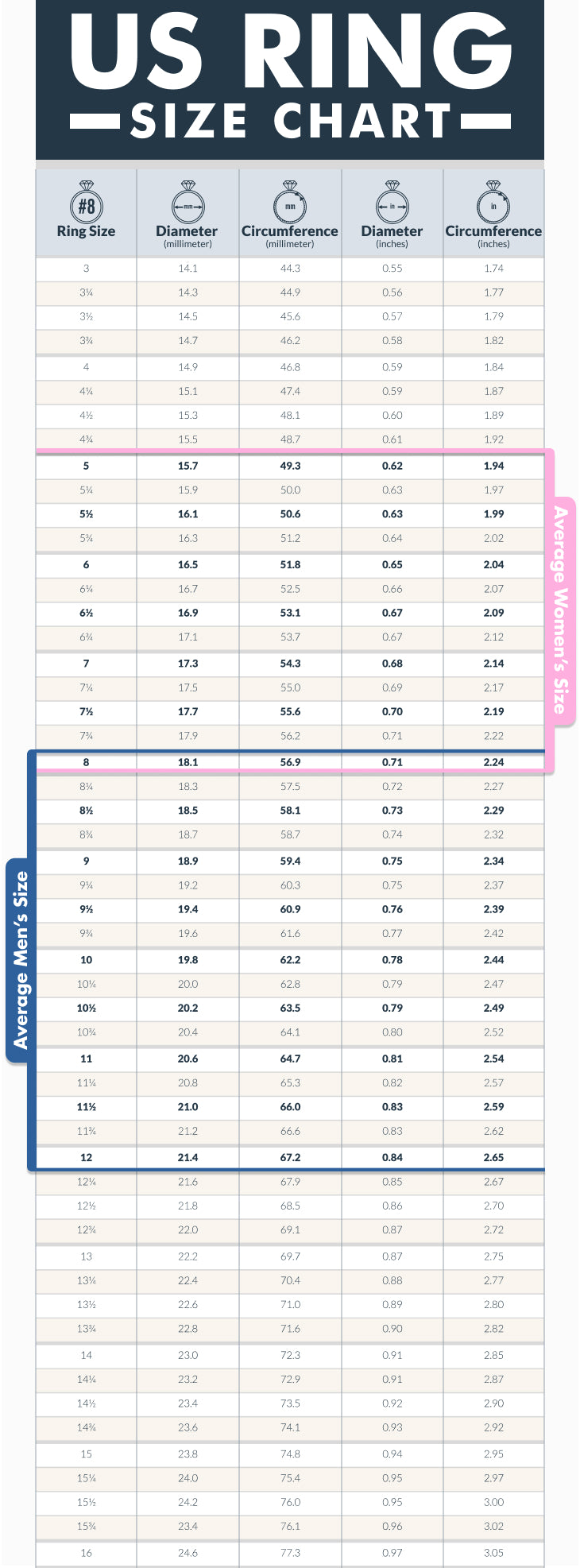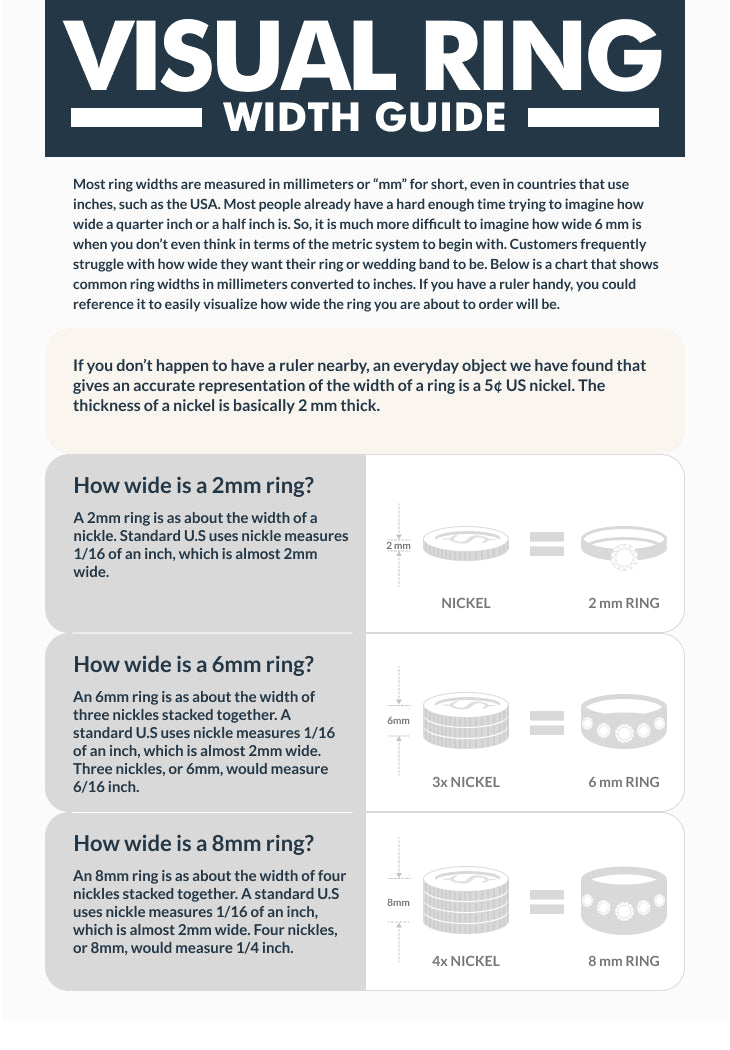SHOP PAY PAYMENT PLANS AVAILABLE. FREE SHIPPING ON YOUR ORDER TODAY!
Size Guide
1. US Ring Size Chart
All jewelers across the US, Canada, and many parts of Mexico use standard US ring sizes when measuring and producing their rings. For those who are not sure of their US ring size, they can figure it out by finding out the diameter or circumference of either a ring they currently wear or by measuring their finger.
All jewelers use basically the same chart, with minor differences due to rounding. Sometimes a finger could get measured at one size by one jeweler and then another jeweler the same finger is measured a half size different from the first jeweler. This is due to the fact that there may be variances in the measurements of the sizes jewelers use.

2. International Ring Size Chart
All jewelers across the US, Canada, and many parts of Mexico use standard US ring sizes when measuring and producing their rings. For those who are not sure of their US ring size, they can figure it out by finding out the diameter or circumference of either a ring they currently wear or by measuring their finger. If you are located outside the US, Canada, and many parts of Mexico, you can refer to the international sizing chart.

US Ring Size System (US, CA, MX) - This system is based on the non-metric British inch and is used not only in the US, but in Canada and Mexico as well.
UK Ring Size System (UK, AU, NZ, ZA, IE) - This system is also used by Ireland, Australia, New Zealand , and South Africa. Sizes are indicated by letters and there are half sizes. Each half size up represents an increase of 0.75 mm of the ring's inside circumference. Size C means the inside circumference of a ring is 40 mm, so size C 1/2 means the circumference is 40.75 mm.
European Ring Size System (FR, RU, DK, SE, NO, FI) - This system is used by most EU countries, such as, France and Scandinavia. It is also used by Russia. There may be other countries that also use this system, which is based on the metric system. The numbers of each size simply translates to the circumference of the inside of the ring in millimeters. So a size 40 would mean the inside circumference of a ring is also 40 mm.
German Ring Size System (DE, AR) - As the name suggests, this is the sizing system used in Germany, but it is also used in other European countries. It is even used in non-European countries, such as Argentina. This system is based on the metric system, but unlike the European system, each number size in this system represents the inside diameter of the ring in millimeters. For example a size 18 means the inside diameter of the ring is 18 mm across.
Brazilian Ring Size System (BR) - This unique sizing system is mainly used in Brazil and perhaps some neighboring countries in South America.
Japanese Ring Size System (JP, CN, KR, HK, TW, SG) - This system is used by East and Southeast Asian countries, like China, Korea, Singapore and Hong Kong. It is also used in South American countries like, Peru and Bolivia. This system is similar to the German system in that it is based on the inside diameter of a ring. However, size 1 starts at 13 mm and each size up represents a 1/3 mm increase in diameter. So, a size 2 is 13.33 mm and size 3 is 13.67 mm.
Swiss Ring Size System (CH, ES) - This system, created by the Swiss, is used in other European countries such as Spain and perhaps in other non-European countries as well, due to the worldwide influence of the Swiss jewelry industry. This system is basically the European system except a size 1 is starts at 40 mm circumference, so a size 2 has an inside circumference of 41 mm.
International Customers: When placing your order, please put your ring size as measured by your local jeweler in the "order notes" section of your shopping cart when checking out, so we can verify for you the correct US size was chosen. You may also take a look at wikipedia's ring size conversion chart, but keep in mind our chart's conversion takes comfort fit sizing into account.
3. Ring Sizer Kit
Our ring sizer is made accurately, so after you find out your correct ring size, you would simply order that same exact size from our website. Because our ring sizer is only 4 mm wide, it is accurate for measuring comfort fit rings. If you are ordering a comfort fit tungsten ring from us, there is no need to drop down half a size, just order the size that best fits your finger.
4. Band Widths for Male and Female Hand
There are a great deal of different ring widths ranging all the way from a very narrow 2mm to a very wide 20mm. If you don’t have a great visual in your head of what that width will look like on your actual hand it can be a bit challenging to get the right ring. Luckily, now there is an easy way to visually see what each ring width will look like your actual hand. Below you’ll see multiple examples of different ring widths on both male and female hands. For women who are wondering what width you should get to go with your engagement ring, we also have a visual showing different widths of wedding bands against an engagement ring. This is a great tool to get a quick visual example of what each ring will look like when on your finger. We really hope these visuals help make your decision much easier.Male Hand
What is a common ring width for a man?
Let me start by saying there is no “right” or “wrong” width for either a man or a woman. The perfect ring width for a man or for a woman is the ring width that you feel fits and looks the best on your particular hand
That being said most men will order a 8mm wide wedding band followed by men ordering 6mm wide wedding bands.
Female Hand
What is a common ring width for a woman?
Most women order a 4mm wedding band. However, depending on how wide your engagement ring is you may want to order a 2mm wide wedding band.
You want to make sure that when combined the width of your wedding band and the width of your engagement ring are not too wide.
5. Visual Ring Width Guide
Most ring widths are measured in millimeters or “mm” for short, even in countries that use inches, such as the USA. Most people already have a hard enough time trying to imagine how wide a quarter inch or a half inch is. So, it is much more difficult to imagine how wide 6 mm is when you don’t even think in terms of the metric system to begin with. Customers frequently struggle with how wide they want their ring or wedding band to be. Below is a chart that shows common ring widths in millimeters converted to inches. If you have a ruler handy, you could reference it to easily visualize how wide the ring you are about to order will be.
If you don’t happen to have a ruler nearby, an everyday object we have found that gives an accurate representation of the width of a ring is a 5¢ US nickel. The thickness of a nickel is basically 2 mm thick.
How wide is a 2mm ring?
A 2mm ring is as about the width of a nickle. Standard U.S uses nickle measures 1/16 of an inch, which is almost 2mm wide.
How wide is a 6mm ring?
An 6mm ring is as about the width of three nickles stacked together. A standard U.S uses nickle measures 1/16 of an inch, which is almost 2mm wide. Three nickles, or 6mm, would measure 6/16 inch.
How wide is an 8mm ring?
An 8mm ring is as about the width of four nickles stacked together. A standard U.S uses nickle measures 1/16 of an inch, which is almost 2mm wide. Four nickles, or 8mm, would measure 1/4 inch.
6. MM to Inch Width Conversion Chart

7. Comfort Fit Sizing Information
North America There are two types of sizing systems in North America: Standard Fit and Comfort Fit. Standard fit rings and wedding bands are the most common types. Comfort Fit is newer and not as well known as Standard Fit.
Both types of fit are explained below.
International Sizing. If you live outside of North America, you can go to a jeweler near you to get your finger measured. Then, go to our international ring size conversion page to find the correct US ring size to order. Or, if you can find out the diameter or circumference of your ring size in millimeters, we will be able to convert it to the proper US size as well.
Comfort Fit
This type of fitting is defined as a ring that is domed in the interior (where the ring touches the finger), instead of flat, like Standard Fit. The diameter at the exact middle of the ring (between the two edges) is smaller than the diameter at the edges of the ring. This type of fit is most commonly used in rings that are difficult to resize, such as tungsten, ceramic, cobalt chrome and titanium. This is why tungsten rings commonly have lifetime replacement programs for sizing, similar to Larson Jewelers’ industry leading no fee lifetime sizing warranty for tungsten wedding bands. The advantages of Comfort Fit are the ring slides over the knuckle easier and the ring creates less friction because it covers less skin surface area.
Determining Comfort Fit Size:
A good method of determining your Comfort Fit size is to first determine your Standard Fit size at a local jeweler (explained below), and then order a half size smaller. For example, if you are measured for a Standard Fit size 9.0 by your local jeweler, you should order a Comfort Fit size 8.5. This is simply a general recommendation, not a hard rule. For rings that are wider than 8 mm, it is not recommended to go down half a size because rings wider than 8 mm fit tighter. Ring sizes are a bit like shoe sizes and differ slightly from manufacturer to manufacturer. This is why different jewelers may measure your finger at slightly different sizes.
Standard Fit
This type of fitting is defined as a ring that is flat along the interior of the ring (where the ring touches the ring finger). This is easiest to illustrate by comparing the interior of the ring to the interior of a pipe, it is the same diameter from one edge to the other. This type of fit is most commonly used in precious metal rings such as platinum, palladium, and white gold. Although it is slightly less comfortable to wear when compared to Comfort Fit, Standard Fit is definitely not “uncomfortable”. Standard Fit has been used in the jewelry industry for centuries.

